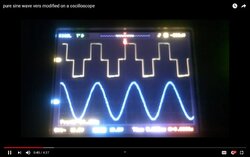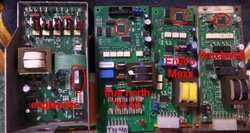Inverter Genny - But is it Pure Sine Wave?
- Thread starter Dataman
- Start date
-
Active since 1995, Hearth.com is THE place on the internet for free information and advice about wood stoves, pellet stoves and other energy saving equipment.
We strive to provide opinions, articles, discussions and history related to Hearth Products and in a more general sense, energy issues.
We promote the EFFICIENT, RESPONSIBLE, CLEAN and SAFE use of all fuels, whether renewable or fossil.
You are using an out of date browser. It may not display this or other websites correctly.
You should upgrade or use an alternative browser.
You should upgrade or use an alternative browser.
Home Depo has it with Free Shipping
https://www.homedepot.com/p/Sportsm...d-Digital-Inverter-Generator-802085/300792167
https://www.homedepot.com/p/Sportsm...d-Digital-Inverter-Generator-802085/300792167
Highbeam
Minister of Fire
peakbagger
Minister of Fire
2011GT/CS
New Member
I bought that exact one a little while ago. It runs my P43 through my APC pure sine wave battery back up. It may be throw away, but for overnight it will run the pellet stove on a half gallon of gas. That’s a lot less fuel than running my Generac 8000 watt unit while sleeping and you only need to keep warm. I figured if I have it last for 10 to 15 uses it will pay for itself. Time will tell, but for now I’m happy with it.
I only need it for Plan B backup. I have inverter with 100ah battery and 2 more small batteries for 6 hour or less power needs. For big ones I have 8k generator for pump and such. Only thing I won't have is Internet (powered thru Meter Base Collar, on Fiber Optics 1000mb).
Seems like it would fit the bill when not wanting to power up the big generator, but still need to charge up battery or run pellet stove and Inverter battery charger. Glad to see user with one here.
Everything is throw away now.
Seems like it would fit the bill when not wanting to power up the big generator, but still need to charge up battery or run pellet stove and Inverter battery charger. Glad to see user with one here.
Everything is throw away now.
Highbeam
Minister of Fire
I only need it for Plan B backup. I have inverter with 100ah battery and 2 more small batteries for 6 hour or less power needs. For big ones I have 8k generator for pump and such. Only thing I won't have is Internet (powered thru Meter Base Collar, on Fiber Optics 1000mb).
Seems like it would fit the bill when not wanting to power up the big generator, but still need to charge up battery or run pellet stove and Inverter battery charger. Glad to see user with one here.
Everything is throw away now.
I don’t think it’s that a small inverter genset wouldn’t be great, it’s that this one may be of low quality.
It is also sold at Home Depo. They are all made in China.
They may look the same... but walmart will have even cheaper components installed and sell it as the same model as other retailers...
Pete Zahria
Minister of Fire
Montecarlossfan
Burning Hunk
I have a backup generator for the whole house but at night I ran my stove (52i) off this exact little guy since instead of chewing through a couple of gallons I went through less than half a gallon.It was 8 hours later and the thing still had fuel in it. Def a great buy for the money even if it lasts through a couple outages.At a price point of $150 that I bought it at..I can say it works pretty damn well for the money.
Highbeam
Minister of Fire
Especially if this thing just charges a ups, I would have a hard time imagining how it could hurt anything.
tlc1976
Minister of Fire
I bought that exact one a little while ago. It runs my P43 through my APC pure sine wave battery back up. It may be throw away, but for overnight it will run the pellet stove on a half gallon of gas. That’s a lot less fuel than running my Generac 8000 watt unit while sleeping and you only need to keep warm. I figured if I have it last for 10 to 15 uses it will pay for itself. Time will tell, but for now I’m happy with it.
I've been thinking of a cheap little generator for the same reason. I have an 8K Generac but according to the manual, it will suck down about $100 of propane in 24 hours. Thankfully all I've had are outages of a few hours every couple months which is fine, but one massive storm and I'm done. All I really need is to run either the pellet stove, or the circulator pump in the boiler to keep the house warm and the pipes from freezing. I like the pellets but that's one reason I miss the woodstove in the old house.
Ashful
Minister of Fire
Especially if this thing just charges a ups, I would have a hard time imagining how it could hurt anything.
Thru an UPS, I have a hard time understanding how ANY cheap generator will hurt anything.
Ssyko
Minister of Fire
There are 3 major types of inverters – pure sine wave (or “true” sine wave), modified sine wave (actually a modified square wave), and square wave.
Pure Sine Wave A pure sine wave is what you get from your local utility company and from some pure sine generators (most generators are not pure sine).
Pure Sine Wave A pure sine wave is what you get from your local utility company and from some pure sine generators (most generators are not pure sine).
- major advantage of a pure sine wave inverter is that all of the equipment which is sold on the market is designed for a pure sine wave. This guarantees that the equipment will work to its full specifications.
- Some appliances, such as motors and microwave ovens will only produce full output with pure sine wave power.
- A few appliances, such as bread makers, light dimmers, and some battery chargers require a pure sine wave to work at all.
- audio equipment, satellite systems, and video equipment, will run properly using pure sine wave inverters.
- these are the most expensive of the inverter designs and outperform all other types of inverters, regardless of use.
- generally most appliances, motors, microwaves, chargers, and power tools will produce full power and not cause any buzzing or negative effects.
- these types of pure sine inverters are not recommended for medical equipment unless manufacturer approved.
- use this inverter for electric shavers and emergency flashlights, garage door openers, laser printers and large strobes used in photography
- Motors, such as refrigerator motor, pumps, fans etc will use more power from the inverter due to lower efficiency. Most motors will use about 20% more power. This is because a fair percentage of a modified sine wave is higher frequencies – that is, not 60 Hz – so the motors cannot use it.
- Some fluorescent lights will not operate quite as bright, and some may buzz or make annoying humming noises.
- Appliances with electronic timers and/or digital clocks will often not operate correctly. Many appliances get their timing from the peak of the line power – basically, the modified sine has a flat top rather than a peak – this may cause the occasional double trigger. Because the modified sine wave is noisier and rougher than a pure sine wave, clocks and timers may run faster or not work at all.
- Items such as bread makers and light dimmers may not work at all – in many cases appliances that use electronic temperature controls will not control. The most common is on such things as variable speed drills will only have two speeds – on and off.
- most equipment will operate without any noticeable difference, and because the lower cost, makes this the most common inverter sold and generally the only type found at your local retailer.
Highbeam
Minister of Fire
Thru an UPS, I have a hard time understanding how ANY cheap generator will hurt anything.
Here in the pellet world with all of those motors and computer boards, these operators are pretty serious about power quality and ups for the sake of power conditioning and so that the thing can shut itself down when the power goes out before the exhaust blower quits.
Ssyko
Minister of Fire
where pure sine wave is used on your stove is the timing in the microcontroler chip. it gets its clock cycles from the peak of the pure sine wave. now non compliant generators, use modified sine wave which are not a smooth round top they are a 2 step square top thus it confuses the crystal in the chip which usually ends up turning something on when it should not causing a short within the circuit


Montecarlossfan
Burning Hunk
Ssyko
Minister of Fire
Ashful
Minister of Fire
where pure sine wave is used on your stove is the timing in the microcontroler chip.
Can you provide a schematic of a stove that employs this? I have a hard time believing anyone would use such an arcane architecture today, or even in the last 30 years.
Ssyko
Minister of Fire
all stove board manufacturers keep their schematics under lock and key. all these use micro controllers. https://itechworld.com.au/blogs/lea...ct-sheet-pure-sine-wave-vs-modified-sine-wave
most appliances use the same components

most appliances use the same components

Similar threads
- Replies
- 14
- Views
- 805
- Replies
- 0
- Views
- 1K
- Replies
- 3
- Views
- 648
- Replies
- 5
- Views
- 488


 . Lawn mowers and other non inverter sets run at 3600 rpm.
. Lawn mowers and other non inverter sets run at 3600 rpm.